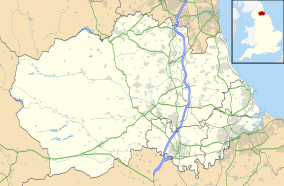Muggleswick, Stanhope and Edmundbyers Commons and Blanchland Moor facts for kids
Quick facts for kids Muggleswick, Stanhope and Edmundbyers Commons and Blanchland Moor |
|
|---|---|
| Location | Derwentside Wear Valley Tynedale, North East, England |
| Area | 9,118.12 ha (35.2053 sq mi) |
| Designated | 1997 |
| Governing body | Natural England |
| Website | Map of site |
Muggleswick, Stanhope and Edmundbyers Commons and Blanchland Moor is a special natural area in County Durham and Northumberland, England. It is known as a Site of Special Scientific Interest (SSSI). This means it's a place with important plants, animals, or geology that needs to be protected.
The site is made up of two separate parts. The larger part includes the high, open lands of Muggleswick, Stanhope, and Edmundbyers Commons. This area is in the northern part of Durham. The smaller part is called Blanchland Moor, and it's located in the southwest of Northumberland. Together, these areas cover about 9,118 hectares, which is like 22,500 football fields!
Contents
Amazing Habitats
This special area has many different types of natural environments. These are called habitats.
Dry Heathland
One of the biggest habitats here is dry heathland. This is a type of open land with low-growing plants. It is common in northern England. The main plants you'll see are heather (Calluna vulgaris) and wavy hair-grass.
Wet Heath and Other Areas
Besides dry heath, there are also areas of wet heath. These spots are usually damp or boggy. You can also find acid grassland, which is grass that grows in acidic soil. There are also "flushes," which are wet areas where water flows out of the ground. Small areas of juniper woodland and open water bodies add to the variety.
Unique Plants
The different habitats support many interesting plants. Some of these plants are quite rare.
Rare Flowers
On the higher parts of Blanchland Moor, you might spot the regionally rare bearberry (Arctostaphylos uva-ursi). This plant has bright red berries. Near streams, you can find other special plants. These include the pale forget-me-not (Myosotis stolonifera), the round-leaved crowfoot (Ranunculus omiophyllus), and the ivy-leaved bellflower (Wahlenbergia hederacea).
Plants from Old Mines
On Stanhope Common, there are old piles of waste from disused lead mines. Here, you can find a nationally scarce plant called spring sandwort (Minuartia verna). This plant is a "metallophyte." This means it can grow in soils that have high levels of metals. It's amazing how some plants can adapt to such tough conditions!
Important Birds
This area is part of the North Pennines moorlands. It is a very important place for many types of birds to breed.
Protected Birds
Some birds here are so important that they need special protection. They are listed in a European plan called the Birds Directive. These include the merlin, the Eurasian golden plover, and the short-eared owl. The merlin is a small falcon, and there are many of them here. This makes the site very special for merlins.
Other Breeding Birds
Many other bird species also breed in this area. These include the red grouse, Eurasian curlew, common redshank, common snipe, and dunlin. These birds are also listed in the United Kingdom's Red Data Book for birds. This means their populations are a concern, and their breeding grounds are very important.


